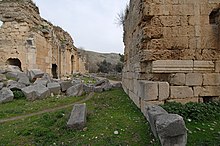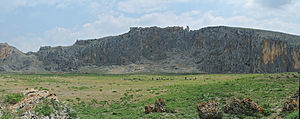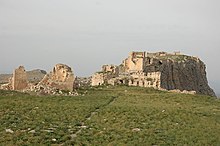Anazarbus
Anavarza (in Turkish) | |
 The triumphal arch of Anazarbus was later converted to the city's South Gate. | |
| Alternative name | Caesarea, Justinopolis |
|---|---|
| Location | Adana Province, Turkey |
| Region | Cilicia |
| Coordinates | 37°15′50″N 35°54′20″E / 37.26389°N 35.90556°E |
| Type | Settlement |
| History | |
| Abandoned | 1374 |


Anazarbus, also known as Justinopolis (
Location
It was situated in
A lofty isolated ridge formed its
History
According to the

Its great natural strength and situation, not far from the mouth of the Sis pass, and near the great road which
Remains




The Crusaders are probably responsible for the construction of an impressive donjon atop the center of the outcrop. Most of the remaining fortifications, including the curtain walls, massive horseshoe-shaped towers, undercrofts, cisterns, and free-standing structures date from the Armenian periods of occupation, which began with the arrival of the
The present wall of the lower city is of late construction. It encloses a mass of ruins conspicuous in which are a fine
A modest Turkish farming village (Dilekkaya) lies to the southwest of the ancient city. A small outdoor museum with some of the artifacts collected in the area can be viewed for a small fee. Also nearby are some beautiful mosaics discovered in a farmers field.
A visit in December 2002 showed that the three aqueducts mentioned above have been nearly completely destroyed. Only small, isolated sections are left standing with the largest portion lying in a pile of rubble that stretches the length of where the aqueducts once stood. A powerful earthquake that struck the area in 1945 is thought to be responsible for the destruction.
In 2013, excavations uncovered the first known colonnaded double-lane road of the ancient world, 34 meters wide and 2700 meters long, also uncovered the ruins of a church and a bathhouse.[13]
In 2017, archaeologists discovered a limestone statue of the goddess Hygieia and the god Eros. The statue is thought to date to the third or fourth century B.C.[13]
Ecclesiastical history
Anazarbus was the capital and so also from 553 (the date of the
In the 4th century, one of the bishops of Anazarbus was Athanasius, a "consistent expounder of the theology of Arius." His theological opponent, Athanasius of Alexandria, in De Synodis 17, 1 refers to Anazarbus as Ναζαρβῶν.[16]
A 6th century
Latin Catholic titular see
The
It is vacant, having had the following incumbents, generally of the highest (Metropolitan) rank, with an episcopal (lowest rank) exception:
- Titular Archbishop Giuseppe Maria Saporiti (1726.04.08 – 1743.12.02)
- Titular Bishop Isidro Alfonso Cavanillas (1753.04.09 – 1755.05.12)
- Titular Archbishop Gerolamo Formagliari (1760.07.21 – 1781)
- Titular Archbishop Romain-Frédéric Gallard (1839.02.21 – 1839.09.28)
- Titular Archbishop Ss. Vitale, Valeria, Gervasio e Protasio(1880.12.16 – 1884.02.28)
- Titular Archbishop Giorgio Labella, Friars Minor(O.F.M.) (1847.06.04 – 1860.10.27)
- Titular Archbishop Charles Petre Eyre (1868.12.03 – 1878.03.15)
- Titular Archbishop John Baptist Salpointe (1884.04.22 – 1885.08.18)
- Titular Archbishop Michael Logue (1887.04.19 – 1887.12.03) (later Cardinal)*
- Titular Archbishop François Laurencin (1888.06.01 – 1892.12.18)
- Titular Archbishop Joaquín Larraín Gandarillas (1893.06.15 – 1897.09.26)
- Titular Archbishop Raimondo Ingheo (1907.12.16 – 1911.07.08)
- Titular Archbishop Cláudio José Gonçalves Ponce de Leon, Lazarists(C.M.) (1912.01.09 – 1924.05.26)
- Titular Archbishop Raymund Netzhammer, Benedictine Order(] O.S.B.) (1924.07.14 – 1945.09.18)
- Titular Archbishop Michele Akras (1945.10.27 – 1947.02.05)
- Titular Archbishop Heinrich Döring (ハインリヒ・デーリング), S.J. (1948.01.15 – 1951.12.17)
- Titular Archbishop Joseph-Marie Le Gouaze (1955.06.24 – 1964.07.31)
Armenian Catholic titular see
In the 19th century, an
It was a suppressed in 1933,[24] having had a single incumbent, of the intermediary (archiepiscopal) rank :
- Titular Archbishop Armenian Catholic Patriarch of Cilicia(Lebanon) ([1931.10.17] 1933.03.13 – 1937.10.26)
Notable locals
- Pedanius Dioscorides (1st century) Greek physician, pharmacologist and botanist
- St. Domnina of Anazarbus[25]
- St. Theodula of Anazarbus[26]
See also
References
Citations
- ^ a b c One or more of the preceding sentences incorporates text from a publication now in the public domain: Hogarth, David George (1911). "Anazarbus". In Chisholm, Hugh (ed.). Encyclopædia Britannica. Vol. 1 (11th ed.). Cambridge University Press. p. 944.
- ^ Suda, s.v. Κύϊνδα.
- ^ Suda Encyclopedia, alpha 1866
- ^ Tobin, Jenner (2001). "The Tarcondimotid Dynasty in Smooth Cilicia". Actes de la Table Ronde d'Istanbul, 2-5 novembre 1999: 381–387.
- ^ Stephanus of Byzantium. Ethnica. Vol. s.v. Ἀνάζαρβος.
- ^ Amm. Marc. 14.8.
- ^ Pliny. Naturalis Historia. Vol. 5.27.
- ^ Southern Europe: International Dictionary of Historic Places. Routledge. 1 January 1996. p. 28.
- JSTOR 27172436.
- ISBN 0-88402-163-7.
- ^ Robert W. Edwards, "Ecclesiastical Architecture in the Fortifications of Armenian Cilicia: First Report, Dumbarton Oaks Papers 36, 1982, pp.156–61, 168, pls.1–7.
- ^ Robert W. Edwards, "Ecclesiastical Architecture in the Fortifications of Armenian Cilicia: Second Report, Dumbarton Oaks Papers 37, 1983, pp.128–34, pls.2, 18–29, 36–46.
- ^ a b Statue of Hygieia and Eros uncovered in southern Turkey
- ISBN 978-0-8028-9016-0.)
{{cite book}}: CS1 maint: multiple names: authors list (link - ^ Oriens christianus: in quatuor patriarchatus digestus : quo exhibentur ... by Michel Le Quien ((O.P.)), Oriens christianus (ex Typographia Regia, 1740) p40.
- ^ R. P. C. Hanson, The Search for the Christian Doctrine of God: The Arian Controversy 318-381 (Edinburgh: T & T Clark, 1988), 41-3, quote, 43.
- ^ The Cannons of the two hundred Holy and Blessed Fathers who met at Ephesus.
- ^ Charles Joseph Hefele, A History of the Councils of the Church: from the Original Documents, to the close of the Second Council of Nicaea A.D. 787 (Wipf and Stock Publishers, 1 February 2007) page 151.
- ^ Michel Le Quien, Oriens christianus in quatuor Patriarchatus digestus, Paris 1740, Vol. II, coll. 885–888
- ^ Gaetano Moroni, Dizionario di erudizione storico-ecclesiastica, Vol. 2, pp. 40–41
- ^ Siméon Vailhé, v. Anazarbe, in Dictionnaire d'Histoire et de Géographie ecclésiastiques, vol. II, Paris 1914, coll. 1504–1506
- ^ Echos d'Orient 1907, p. 95.
- ISBN 978-88-209-9070-1).
- ^ Hierarchia Catholica Medii et Recentioris Aevi, Volume 8, Page 99, and Page 328.
- ^ Domina of Anazarbus.
- ^ St. Theodula of Anazarbus in Cilicia.
General references
- Entry for Anazarbus from the Suda.
![]() This article incorporates text from a publication now in the public domain: Smith, William, ed. (1854–1857). "Anazarbus". Dictionary of Greek and Roman Geography. London: John Murray.
This article incorporates text from a publication now in the public domain: Smith, William, ed. (1854–1857). "Anazarbus". Dictionary of Greek and Roman Geography. London: John Murray.

